Strategic Health Leadership and Management Article Critique Report
VerifiedAdded on 2023/01/13
|9
|2652
|49
Report
AI Summary
This report presents a comprehensive critique of an article focusing on strategic health leadership and management, specifically examining the implementation and sustainability of transformational change through clinical process redesign. The analysis delves into the core concepts, principles, and practical applications of redesigning clinical processes to improve healthcare services, as highlighted in the article. It explores the significance of leadership, the importance of patient journeys, and the utilization of evidence-based strategies for effective healthcare management. The critique evaluates the methodologies employed, including research approaches, data collection techniques, and the integration of various viewpoints. Furthermore, it identifies the strengths of the article, such as the in-depth analysis, the use of examples, and the incorporation of secondary research methods, while also acknowledging any limitations, such as the absence of specific research gaps and the scope of information provided. The report concludes by summarizing the key findings and implications for health leadership and management in enhancing healthcare outcomes.

Strategic health leadership and management
Paraphrase This Document
Need a fresh take? Get an instant paraphrase of this document with our AI Paraphraser

ARTICLE CRITIQUE
1
Contents
Introduction....................................................................................................................................................... 2
Article Critique.................................................................................................................................................. 2
Conclusion........................................................................................................................................................... 6
References........................................................................................................................................................... 7
1
Contents
Introduction....................................................................................................................................................... 2
Article Critique.................................................................................................................................................. 2
Conclusion........................................................................................................................................................... 6
References........................................................................................................................................................... 7
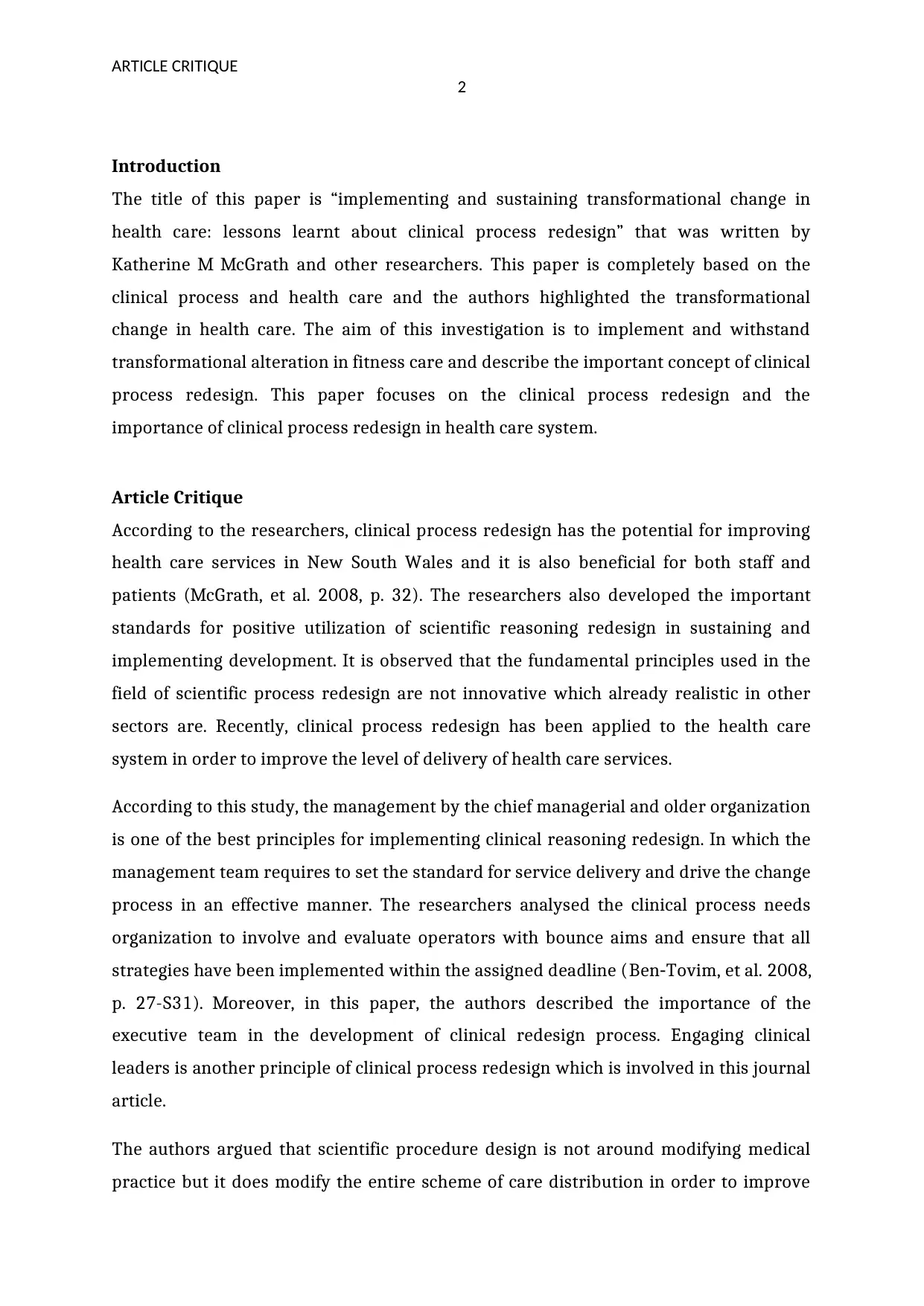
ARTICLE CRITIQUE
2
Introduction
The title of this paper is “implementing and sustaining transformational change in
health care: lessons learnt about clinical process redesign” that was written by
Katherine M McGrath and other researchers. This paper is completely based on the
clinical process and health care and the authors highlighted the transformational
change in health care. The aim of this investigation is to implement and withstand
transformational alteration in fitness care and describe the important concept of clinical
process redesign. This paper focuses on the clinical process redesign and the
importance of clinical process redesign in health care system.
Article Critique
According to the researchers, clinical process redesign has the potential for improving
health care services in New South Wales and it is also beneficial for both staff and
patients (McGrath, et al. 2008, p. 32). The researchers also developed the important
standards for positive utilization of scientific reasoning redesign in sustaining and
implementing development. It is observed that the fundamental principles used in the
field of scientific process redesign are not innovative which already realistic in other
sectors are. Recently, clinical process redesign has been applied to the health care
system in order to improve the level of delivery of health care services.
According to this study, the management by the chief managerial and older organization
is one of the best principles for implementing clinical reasoning redesign. In which the
management team requires to set the standard for service delivery and drive the change
process in an effective manner. The researchers analysed the clinical process needs
organization to involve and evaluate operators with bounce aims and ensure that all
strategies have been implemented within the assigned deadline (Ben‐Tovim, et al. 2008,
p. 27-S31). Moreover, in this paper, the authors described the importance of the
executive team in the development of clinical redesign process. Engaging clinical
leaders is another principle of clinical process redesign which is involved in this journal
article.
The authors argued that scientific procedure design is not around modifying medical
practice but it does modify the entire scheme of care distribution in order to improve
2
Introduction
The title of this paper is “implementing and sustaining transformational change in
health care: lessons learnt about clinical process redesign” that was written by
Katherine M McGrath and other researchers. This paper is completely based on the
clinical process and health care and the authors highlighted the transformational
change in health care. The aim of this investigation is to implement and withstand
transformational alteration in fitness care and describe the important concept of clinical
process redesign. This paper focuses on the clinical process redesign and the
importance of clinical process redesign in health care system.
Article Critique
According to the researchers, clinical process redesign has the potential for improving
health care services in New South Wales and it is also beneficial for both staff and
patients (McGrath, et al. 2008, p. 32). The researchers also developed the important
standards for positive utilization of scientific reasoning redesign in sustaining and
implementing development. It is observed that the fundamental principles used in the
field of scientific process redesign are not innovative which already realistic in other
sectors are. Recently, clinical process redesign has been applied to the health care
system in order to improve the level of delivery of health care services.
According to this study, the management by the chief managerial and older organization
is one of the best principles for implementing clinical reasoning redesign. In which the
management team requires to set the standard for service delivery and drive the change
process in an effective manner. The researchers analysed the clinical process needs
organization to involve and evaluate operators with bounce aims and ensure that all
strategies have been implemented within the assigned deadline (Ben‐Tovim, et al. 2008,
p. 27-S31). Moreover, in this paper, the authors described the importance of the
executive team in the development of clinical redesign process. Engaging clinical
leaders is another principle of clinical process redesign which is involved in this journal
article.
The authors argued that scientific procedure design is not around modifying medical
practice but it does modify the entire scheme of care distribution in order to improve
⊘ This is a preview!⊘
Do you want full access?
Subscribe today to unlock all pages.

Trusted by 1+ million students worldwide
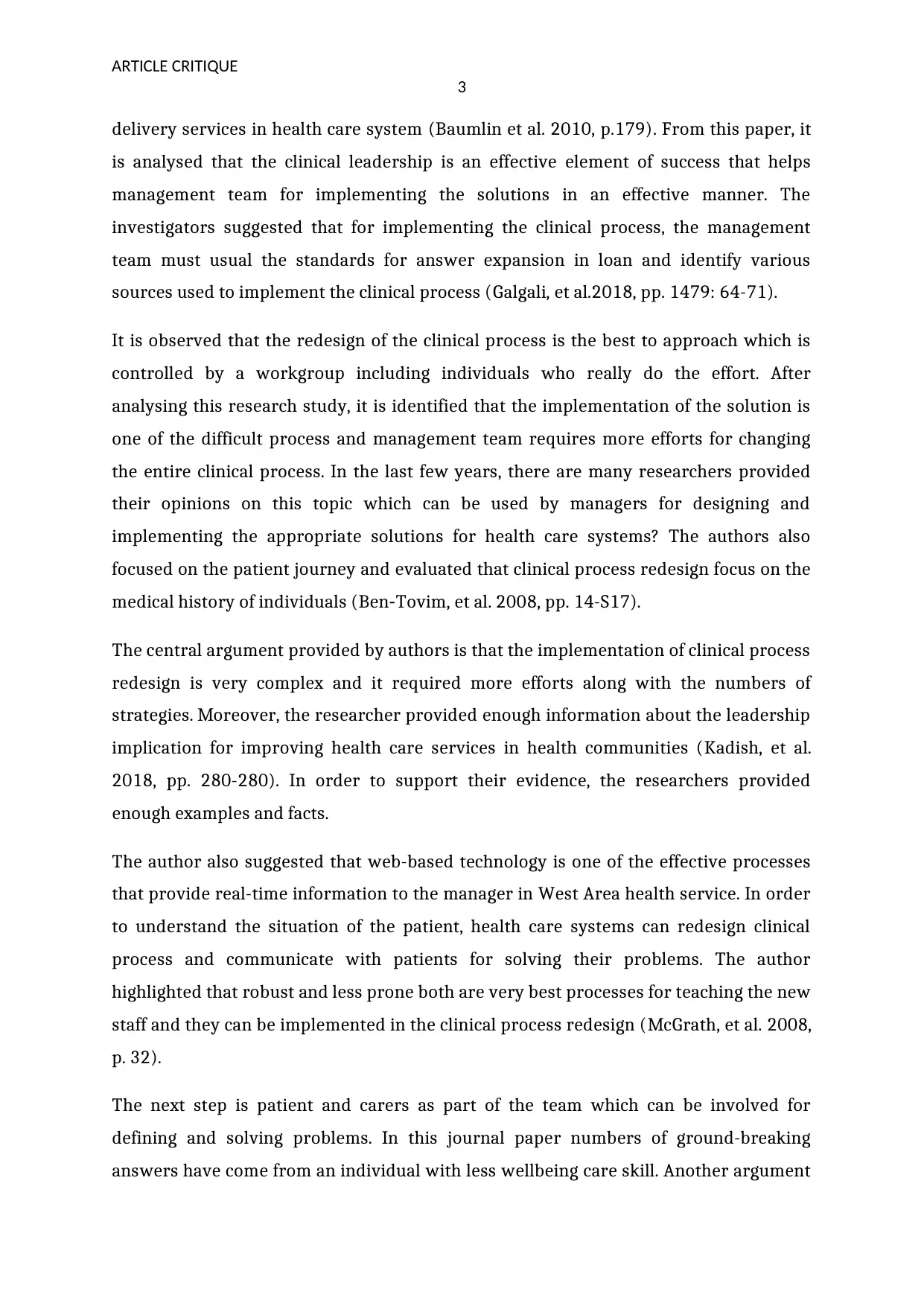
ARTICLE CRITIQUE
3
delivery services in health care system (Baumlin et al. 2010, p.179). From this paper, it
is analysed that the clinical leadership is an effective element of success that helps
management team for implementing the solutions in an effective manner. The
investigators suggested that for implementing the clinical process, the management
team must usual the standards for answer expansion in loan and identify various
sources used to implement the clinical process (Galgali, et al.2018, pp. 1479: 64-71).
It is observed that the redesign of the clinical process is the best to approach which is
controlled by a workgroup including individuals who really do the effort. After
analysing this research study, it is identified that the implementation of the solution is
one of the difficult process and management team requires more efforts for changing
the entire clinical process. In the last few years, there are many researchers provided
their opinions on this topic which can be used by managers for designing and
implementing the appropriate solutions for health care systems? The authors also
focused on the patient journey and evaluated that clinical process redesign focus on the
medical history of individuals (Ben‐Tovim, et al. 2008, pp. 14-S17).
The central argument provided by authors is that the implementation of clinical process
redesign is very complex and it required more efforts along with the numbers of
strategies. Moreover, the researcher provided enough information about the leadership
implication for improving health care services in health communities (Kadish, et al.
2018, pp. 280-280). In order to support their evidence, the researchers provided
enough examples and facts.
The author also suggested that web-based technology is one of the effective processes
that provide real-time information to the manager in West Area health service. In order
to understand the situation of the patient, health care systems can redesign clinical
process and communicate with patients for solving their problems. The author
highlighted that robust and less prone both are very best processes for teaching the new
staff and they can be implemented in the clinical process redesign (McGrath, et al. 2008,
p. 32).
The next step is patient and carers as part of the team which can be involved for
defining and solving problems. In this journal paper numbers of ground-breaking
answers have come from an individual with less wellbeing care skill. Another argument
3
delivery services in health care system (Baumlin et al. 2010, p.179). From this paper, it
is analysed that the clinical leadership is an effective element of success that helps
management team for implementing the solutions in an effective manner. The
investigators suggested that for implementing the clinical process, the management
team must usual the standards for answer expansion in loan and identify various
sources used to implement the clinical process (Galgali, et al.2018, pp. 1479: 64-71).
It is observed that the redesign of the clinical process is the best to approach which is
controlled by a workgroup including individuals who really do the effort. After
analysing this research study, it is identified that the implementation of the solution is
one of the difficult process and management team requires more efforts for changing
the entire clinical process. In the last few years, there are many researchers provided
their opinions on this topic which can be used by managers for designing and
implementing the appropriate solutions for health care systems? The authors also
focused on the patient journey and evaluated that clinical process redesign focus on the
medical history of individuals (Ben‐Tovim, et al. 2008, pp. 14-S17).
The central argument provided by authors is that the implementation of clinical process
redesign is very complex and it required more efforts along with the numbers of
strategies. Moreover, the researcher provided enough information about the leadership
implication for improving health care services in health communities (Kadish, et al.
2018, pp. 280-280). In order to support their evidence, the researchers provided
enough examples and facts.
The author also suggested that web-based technology is one of the effective processes
that provide real-time information to the manager in West Area health service. In order
to understand the situation of the patient, health care systems can redesign clinical
process and communicate with patients for solving their problems. The author
highlighted that robust and less prone both are very best processes for teaching the new
staff and they can be implemented in the clinical process redesign (McGrath, et al. 2008,
p. 32).
The next step is patient and carers as part of the team which can be involved for
defining and solving problems. In this journal paper numbers of ground-breaking
answers have come from an individual with less wellbeing care skill. Another argument
Paraphrase This Document
Need a fresh take? Get an instant paraphrase of this document with our AI Paraphraser
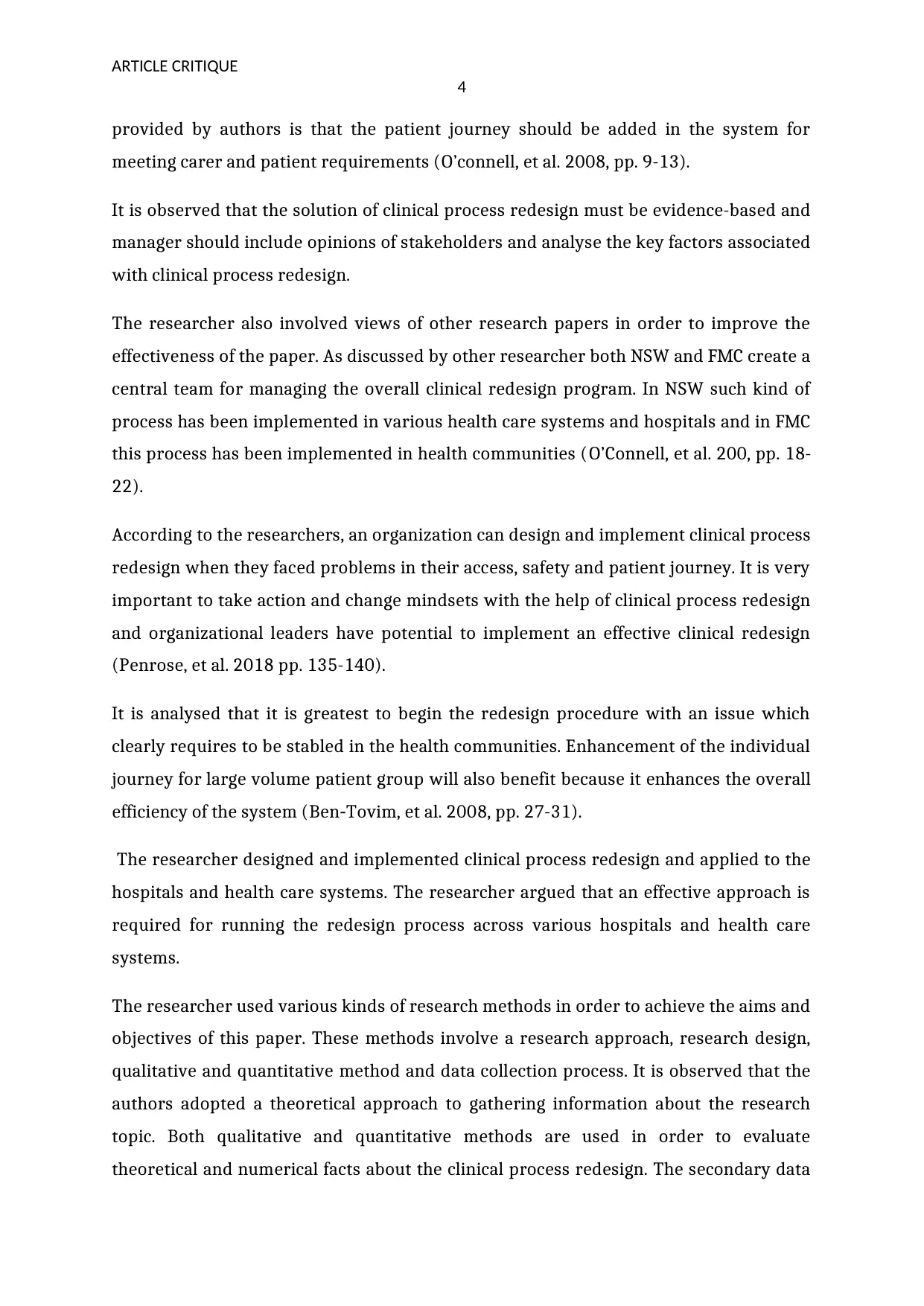
ARTICLE CRITIQUE
4
provided by authors is that the patient journey should be added in the system for
meeting carer and patient requirements (O’connell, et al. 2008, pp. 9-13).
It is observed that the solution of clinical process redesign must be evidence-based and
manager should include opinions of stakeholders and analyse the key factors associated
with clinical process redesign.
The researcher also involved views of other research papers in order to improve the
effectiveness of the paper. As discussed by other researcher both NSW and FMC create a
central team for managing the overall clinical redesign program. In NSW such kind of
process has been implemented in various health care systems and hospitals and in FMC
this process has been implemented in health communities (O’Connell, et al. 200, pp. 18-
22).
According to the researchers, an organization can design and implement clinical process
redesign when they faced problems in their access, safety and patient journey. It is very
important to take action and change mindsets with the help of clinical process redesign
and organizational leaders have potential to implement an effective clinical redesign
(Penrose, et al. 2018 pp. 135-140).
It is analysed that it is greatest to begin the redesign procedure with an issue which
clearly requires to be stabled in the health communities. Enhancement of the individual
journey for large volume patient group will also benefit because it enhances the overall
efficiency of the system (Ben‐Tovim, et al. 2008, pp. 27-31).
The researcher designed and implemented clinical process redesign and applied to the
hospitals and health care systems. The researcher argued that an effective approach is
required for running the redesign process across various hospitals and health care
systems.
The researcher used various kinds of research methods in order to achieve the aims and
objectives of this paper. These methods involve a research approach, research design,
qualitative and quantitative method and data collection process. It is observed that the
authors adopted a theoretical approach to gathering information about the research
topic. Both qualitative and quantitative methods are used in order to evaluate
theoretical and numerical facts about the clinical process redesign. The secondary data
4
provided by authors is that the patient journey should be added in the system for
meeting carer and patient requirements (O’connell, et al. 2008, pp. 9-13).
It is observed that the solution of clinical process redesign must be evidence-based and
manager should include opinions of stakeholders and analyse the key factors associated
with clinical process redesign.
The researcher also involved views of other research papers in order to improve the
effectiveness of the paper. As discussed by other researcher both NSW and FMC create a
central team for managing the overall clinical redesign program. In NSW such kind of
process has been implemented in various health care systems and hospitals and in FMC
this process has been implemented in health communities (O’Connell, et al. 200, pp. 18-
22).
According to the researchers, an organization can design and implement clinical process
redesign when they faced problems in their access, safety and patient journey. It is very
important to take action and change mindsets with the help of clinical process redesign
and organizational leaders have potential to implement an effective clinical redesign
(Penrose, et al. 2018 pp. 135-140).
It is analysed that it is greatest to begin the redesign procedure with an issue which
clearly requires to be stabled in the health communities. Enhancement of the individual
journey for large volume patient group will also benefit because it enhances the overall
efficiency of the system (Ben‐Tovim, et al. 2008, pp. 27-31).
The researcher designed and implemented clinical process redesign and applied to the
hospitals and health care systems. The researcher argued that an effective approach is
required for running the redesign process across various hospitals and health care
systems.
The researcher used various kinds of research methods in order to achieve the aims and
objectives of this paper. These methods involve a research approach, research design,
qualitative and quantitative method and data collection process. It is observed that the
authors adopted a theoretical approach to gathering information about the research
topic. Both qualitative and quantitative methods are used in order to evaluate
theoretical and numerical facts about the clinical process redesign. The secondary data
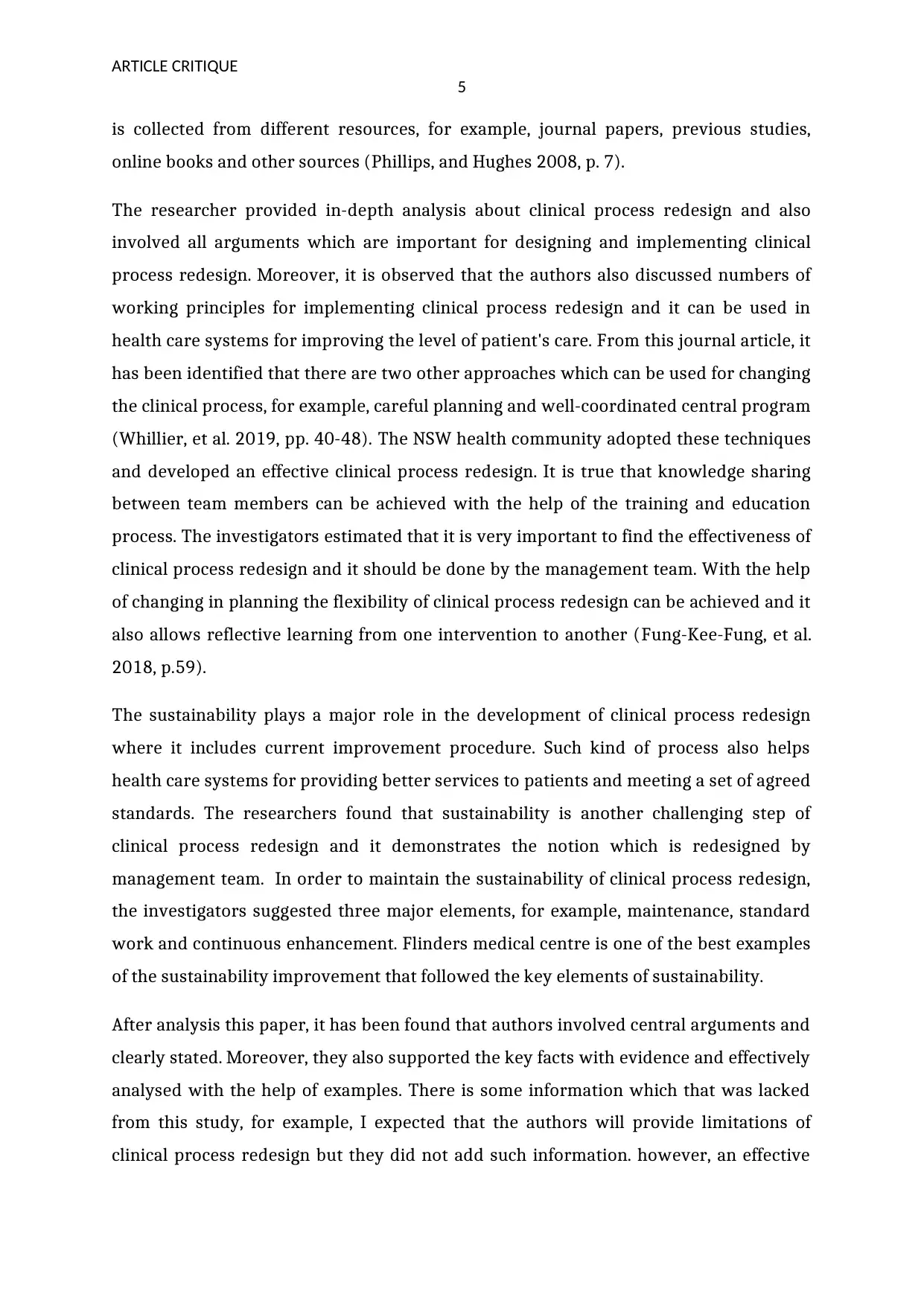
ARTICLE CRITIQUE
5
is collected from different resources, for example, journal papers, previous studies,
online books and other sources (Phillips, and Hughes 2008, p. 7).
The researcher provided in-depth analysis about clinical process redesign and also
involved all arguments which are important for designing and implementing clinical
process redesign. Moreover, it is observed that the authors also discussed numbers of
working principles for implementing clinical process redesign and it can be used in
health care systems for improving the level of patient's care. From this journal article, it
has been identified that there are two other approaches which can be used for changing
the clinical process, for example, careful planning and well-coordinated central program
(Whillier, et al. 2019, pp. 40-48). The NSW health community adopted these techniques
and developed an effective clinical process redesign. It is true that knowledge sharing
between team members can be achieved with the help of the training and education
process. The investigators estimated that it is very important to find the effectiveness of
clinical process redesign and it should be done by the management team. With the help
of changing in planning the flexibility of clinical process redesign can be achieved and it
also allows reflective learning from one intervention to another (Fung-Kee-Fung, et al.
2018, p.59).
The sustainability plays a major role in the development of clinical process redesign
where it includes current improvement procedure. Such kind of process also helps
health care systems for providing better services to patients and meeting a set of agreed
standards. The researchers found that sustainability is another challenging step of
clinical process redesign and it demonstrates the notion which is redesigned by
management team. In order to maintain the sustainability of clinical process redesign,
the investigators suggested three major elements, for example, maintenance, standard
work and continuous enhancement. Flinders medical centre is one of the best examples
of the sustainability improvement that followed the key elements of sustainability.
After analysis this paper, it has been found that authors involved central arguments and
clearly stated. Moreover, they also supported the key facts with evidence and effectively
analysed with the help of examples. There is some information which that was lacked
from this study, for example, I expected that the authors will provide limitations of
clinical process redesign but they did not add such information. however, an effective
5
is collected from different resources, for example, journal papers, previous studies,
online books and other sources (Phillips, and Hughes 2008, p. 7).
The researcher provided in-depth analysis about clinical process redesign and also
involved all arguments which are important for designing and implementing clinical
process redesign. Moreover, it is observed that the authors also discussed numbers of
working principles for implementing clinical process redesign and it can be used in
health care systems for improving the level of patient's care. From this journal article, it
has been identified that there are two other approaches which can be used for changing
the clinical process, for example, careful planning and well-coordinated central program
(Whillier, et al. 2019, pp. 40-48). The NSW health community adopted these techniques
and developed an effective clinical process redesign. It is true that knowledge sharing
between team members can be achieved with the help of the training and education
process. The investigators estimated that it is very important to find the effectiveness of
clinical process redesign and it should be done by the management team. With the help
of changing in planning the flexibility of clinical process redesign can be achieved and it
also allows reflective learning from one intervention to another (Fung-Kee-Fung, et al.
2018, p.59).
The sustainability plays a major role in the development of clinical process redesign
where it includes current improvement procedure. Such kind of process also helps
health care systems for providing better services to patients and meeting a set of agreed
standards. The researchers found that sustainability is another challenging step of
clinical process redesign and it demonstrates the notion which is redesigned by
management team. In order to maintain the sustainability of clinical process redesign,
the investigators suggested three major elements, for example, maintenance, standard
work and continuous enhancement. Flinders medical centre is one of the best examples
of the sustainability improvement that followed the key elements of sustainability.
After analysis this paper, it has been found that authors involved central arguments and
clearly stated. Moreover, they also supported the key facts with evidence and effectively
analysed with the help of examples. There is some information which that was lacked
from this study, for example, I expected that the authors will provide limitations of
clinical process redesign but they did not add such information. however, an effective
⊘ This is a preview!⊘
Do you want full access?
Subscribe today to unlock all pages.

Trusted by 1+ million students worldwide
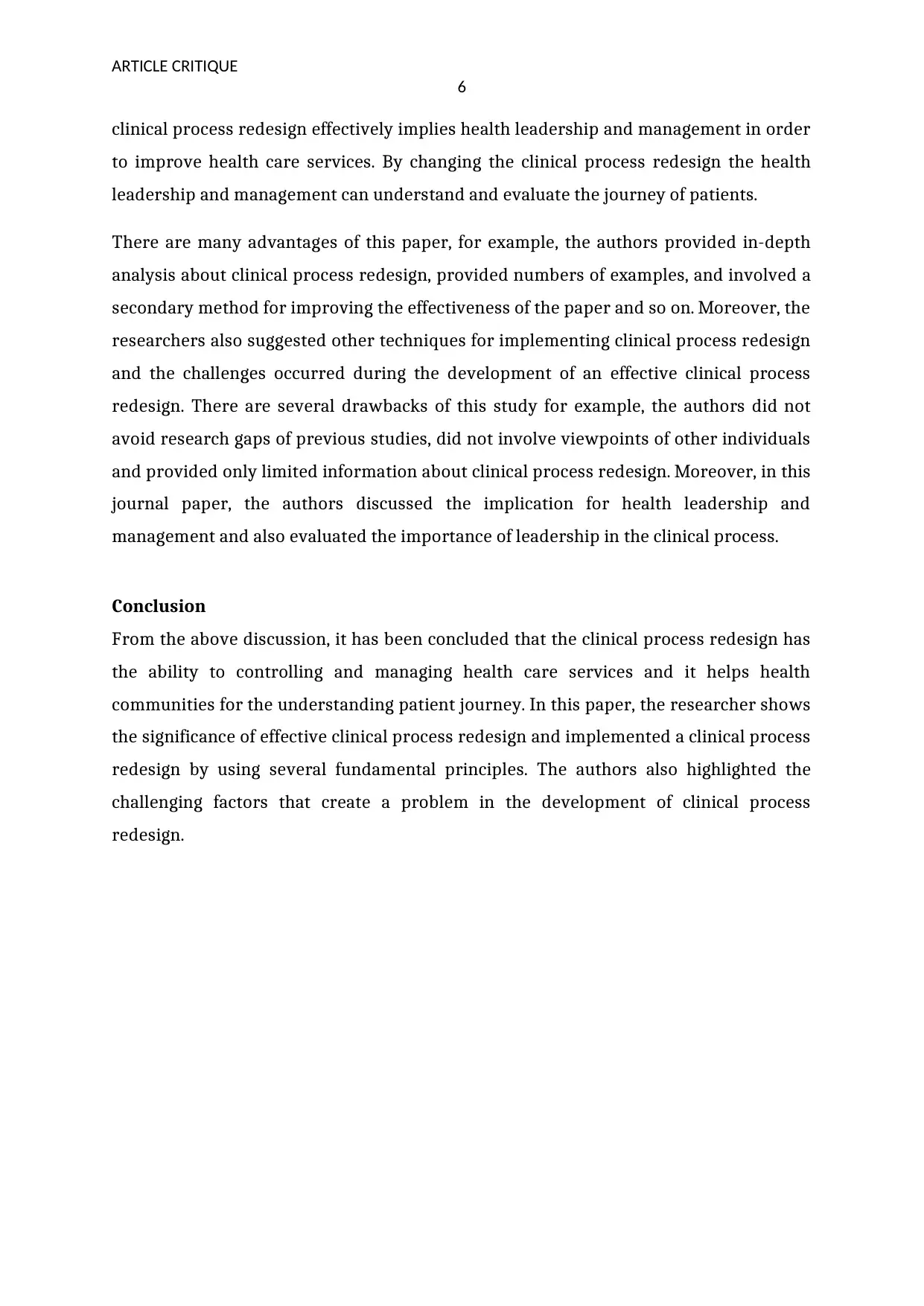
ARTICLE CRITIQUE
6
clinical process redesign effectively implies health leadership and management in order
to improve health care services. By changing the clinical process redesign the health
leadership and management can understand and evaluate the journey of patients.
There are many advantages of this paper, for example, the authors provided in-depth
analysis about clinical process redesign, provided numbers of examples, and involved a
secondary method for improving the effectiveness of the paper and so on. Moreover, the
researchers also suggested other techniques for implementing clinical process redesign
and the challenges occurred during the development of an effective clinical process
redesign. There are several drawbacks of this study for example, the authors did not
avoid research gaps of previous studies, did not involve viewpoints of other individuals
and provided only limited information about clinical process redesign. Moreover, in this
journal paper, the authors discussed the implication for health leadership and
management and also evaluated the importance of leadership in the clinical process.
Conclusion
From the above discussion, it has been concluded that the clinical process redesign has
the ability to controlling and managing health care services and it helps health
communities for the understanding patient journey. In this paper, the researcher shows
the significance of effective clinical process redesign and implemented a clinical process
redesign by using several fundamental principles. The authors also highlighted the
challenging factors that create a problem in the development of clinical process
redesign.
6
clinical process redesign effectively implies health leadership and management in order
to improve health care services. By changing the clinical process redesign the health
leadership and management can understand and evaluate the journey of patients.
There are many advantages of this paper, for example, the authors provided in-depth
analysis about clinical process redesign, provided numbers of examples, and involved a
secondary method for improving the effectiveness of the paper and so on. Moreover, the
researchers also suggested other techniques for implementing clinical process redesign
and the challenges occurred during the development of an effective clinical process
redesign. There are several drawbacks of this study for example, the authors did not
avoid research gaps of previous studies, did not involve viewpoints of other individuals
and provided only limited information about clinical process redesign. Moreover, in this
journal paper, the authors discussed the implication for health leadership and
management and also evaluated the importance of leadership in the clinical process.
Conclusion
From the above discussion, it has been concluded that the clinical process redesign has
the ability to controlling and managing health care services and it helps health
communities for the understanding patient journey. In this paper, the researcher shows
the significance of effective clinical process redesign and implemented a clinical process
redesign by using several fundamental principles. The authors also highlighted the
challenging factors that create a problem in the development of clinical process
redesign.
Paraphrase This Document
Need a fresh take? Get an instant paraphrase of this document with our AI Paraphraser
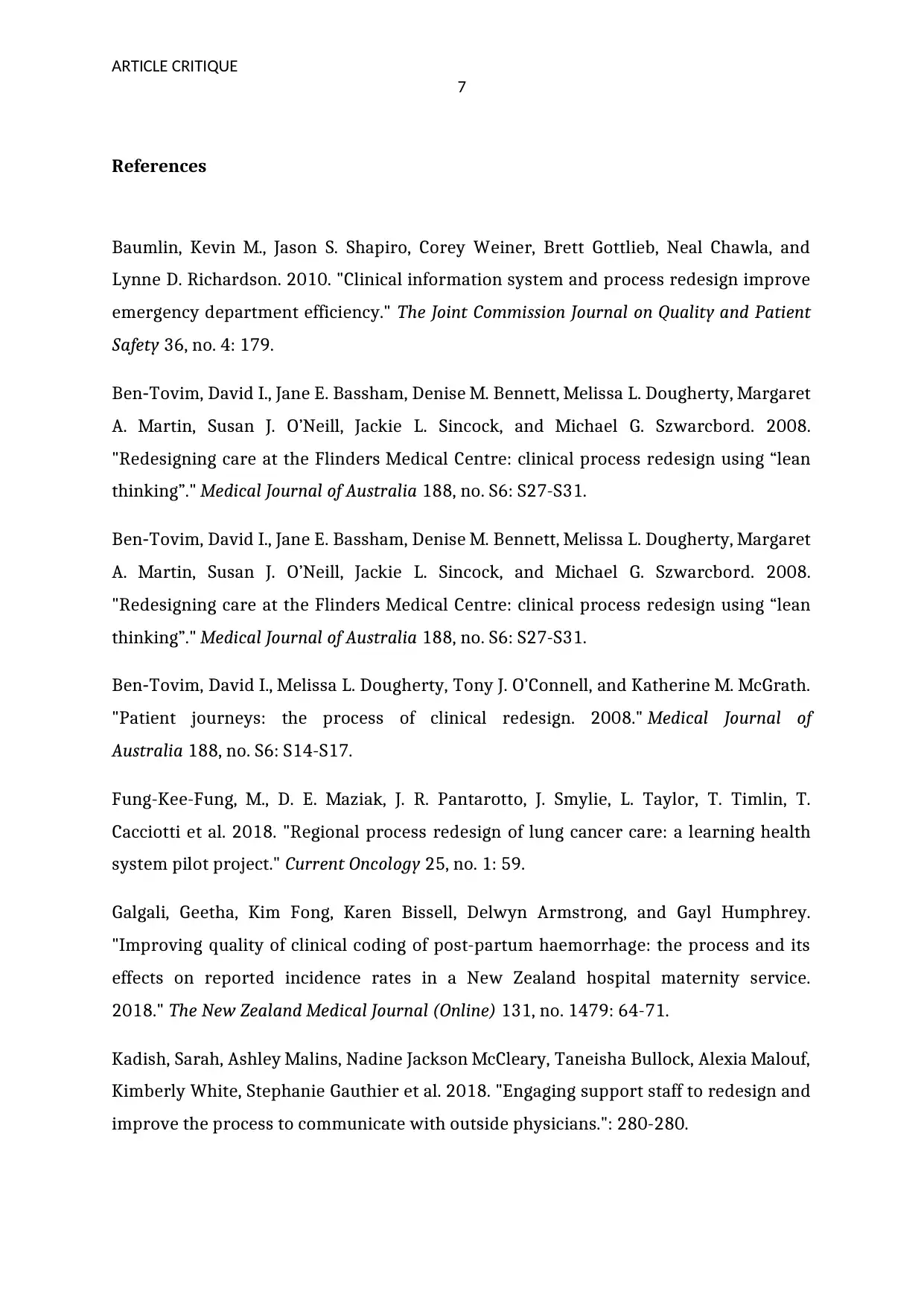
ARTICLE CRITIQUE
7
References
Baumlin, Kevin M., Jason S. Shapiro, Corey Weiner, Brett Gottlieb, Neal Chawla, and
Lynne D. Richardson. 2010. "Clinical information system and process redesign improve
emergency department efficiency." The Joint Commission Journal on Quality and Patient
Safety 36, no. 4: 179.
Ben‐Tovim, David I., Jane E. Bassham, Denise M. Bennett, Melissa L. Dougherty, Margaret
A. Martin, Susan J. O’Neill, Jackie L. Sincock, and Michael G. Szwarcbord. 2008.
"Redesigning care at the Flinders Medical Centre: clinical process redesign using “lean
thinking”." Medical Journal of Australia 188, no. S6: S27-S31.
Ben‐Tovim, David I., Jane E. Bassham, Denise M. Bennett, Melissa L. Dougherty, Margaret
A. Martin, Susan J. O’Neill, Jackie L. Sincock, and Michael G. Szwarcbord. 2008.
"Redesigning care at the Flinders Medical Centre: clinical process redesign using “lean
thinking”." Medical Journal of Australia 188, no. S6: S27-S31.
Ben‐Tovim, David I., Melissa L. Dougherty, Tony J. O’Connell, and Katherine M. McGrath.
"Patient journeys: the process of clinical redesign. 2008." Medical Journal of
Australia 188, no. S6: S14-S17.
Fung-Kee-Fung, M., D. E. Maziak, J. R. Pantarotto, J. Smylie, L. Taylor, T. Timlin, T.
Cacciotti et al. 2018. "Regional process redesign of lung cancer care: a learning health
system pilot project." Current Oncology 25, no. 1: 59.
Galgali, Geetha, Kim Fong, Karen Bissell, Delwyn Armstrong, and Gayl Humphrey.
"Improving quality of clinical coding of post-partum haemorrhage: the process and its
effects on reported incidence rates in a New Zealand hospital maternity service.
2018." The New Zealand Medical Journal (Online) 131, no. 1479: 64-71.
Kadish, Sarah, Ashley Malins, Nadine Jackson McCleary, Taneisha Bullock, Alexia Malouf,
Kimberly White, Stephanie Gauthier et al. 2018. "Engaging support staff to redesign and
improve the process to communicate with outside physicians.": 280-280.
7
References
Baumlin, Kevin M., Jason S. Shapiro, Corey Weiner, Brett Gottlieb, Neal Chawla, and
Lynne D. Richardson. 2010. "Clinical information system and process redesign improve
emergency department efficiency." The Joint Commission Journal on Quality and Patient
Safety 36, no. 4: 179.
Ben‐Tovim, David I., Jane E. Bassham, Denise M. Bennett, Melissa L. Dougherty, Margaret
A. Martin, Susan J. O’Neill, Jackie L. Sincock, and Michael G. Szwarcbord. 2008.
"Redesigning care at the Flinders Medical Centre: clinical process redesign using “lean
thinking”." Medical Journal of Australia 188, no. S6: S27-S31.
Ben‐Tovim, David I., Jane E. Bassham, Denise M. Bennett, Melissa L. Dougherty, Margaret
A. Martin, Susan J. O’Neill, Jackie L. Sincock, and Michael G. Szwarcbord. 2008.
"Redesigning care at the Flinders Medical Centre: clinical process redesign using “lean
thinking”." Medical Journal of Australia 188, no. S6: S27-S31.
Ben‐Tovim, David I., Melissa L. Dougherty, Tony J. O’Connell, and Katherine M. McGrath.
"Patient journeys: the process of clinical redesign. 2008." Medical Journal of
Australia 188, no. S6: S14-S17.
Fung-Kee-Fung, M., D. E. Maziak, J. R. Pantarotto, J. Smylie, L. Taylor, T. Timlin, T.
Cacciotti et al. 2018. "Regional process redesign of lung cancer care: a learning health
system pilot project." Current Oncology 25, no. 1: 59.
Galgali, Geetha, Kim Fong, Karen Bissell, Delwyn Armstrong, and Gayl Humphrey.
"Improving quality of clinical coding of post-partum haemorrhage: the process and its
effects on reported incidence rates in a New Zealand hospital maternity service.
2018." The New Zealand Medical Journal (Online) 131, no. 1479: 64-71.
Kadish, Sarah, Ashley Malins, Nadine Jackson McCleary, Taneisha Bullock, Alexia Malouf,
Kimberly White, Stephanie Gauthier et al. 2018. "Engaging support staff to redesign and
improve the process to communicate with outside physicians.": 280-280.
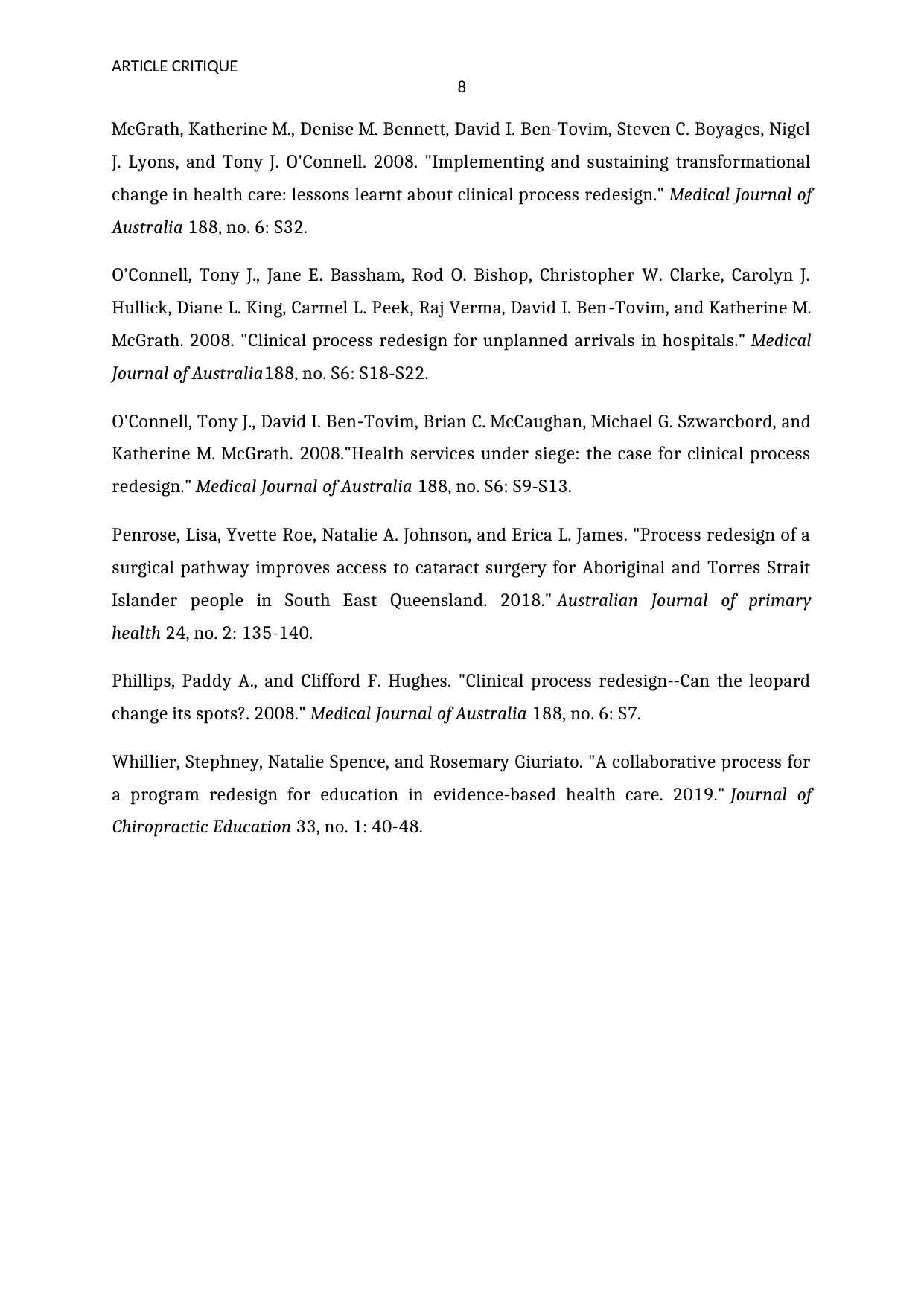
ARTICLE CRITIQUE
8
McGrath, Katherine M., Denise M. Bennett, David I. Ben-Tovim, Steven C. Boyages, Nigel
J. Lyons, and Tony J. O'Connell. 2008. "Implementing and sustaining transformational
change in health care: lessons learnt about clinical process redesign." Medical Journal of
Australia 188, no. 6: S32.
O’Connell, Tony J., Jane E. Bassham, Rod O. Bishop, Christopher W. Clarke, Carolyn J.
Hullick, Diane L. King, Carmel L. Peek, Raj Verma, David I. Ben‐Tovim, and Katherine M.
McGrath. 2008. "Clinical process redesign for unplanned arrivals in hospitals." Medical
Journal of Australia188, no. S6: S18-S22.
O'Connell, Tony J., David I. Ben‐Tovim, Brian C. McCaughan, Michael G. Szwarcbord, and
Katherine M. McGrath. 2008."Health services under siege: the case for clinical process
redesign." Medical Journal of Australia 188, no. S6: S9-S13.
Penrose, Lisa, Yvette Roe, Natalie A. Johnson, and Erica L. James. "Process redesign of a
surgical pathway improves access to cataract surgery for Aboriginal and Torres Strait
Islander people in South East Queensland. 2018." Australian Journal of primary
health 24, no. 2: 135-140.
Phillips, Paddy A., and Clifford F. Hughes. "Clinical process redesign--Can the leopard
change its spots?. 2008." Medical Journal of Australia 188, no. 6: S7.
Whillier, Stephney, Natalie Spence, and Rosemary Giuriato. "A collaborative process for
a program redesign for education in evidence-based health care. 2019." Journal of
Chiropractic Education 33, no. 1: 40-48.
8
McGrath, Katherine M., Denise M. Bennett, David I. Ben-Tovim, Steven C. Boyages, Nigel
J. Lyons, and Tony J. O'Connell. 2008. "Implementing and sustaining transformational
change in health care: lessons learnt about clinical process redesign." Medical Journal of
Australia 188, no. 6: S32.
O’Connell, Tony J., Jane E. Bassham, Rod O. Bishop, Christopher W. Clarke, Carolyn J.
Hullick, Diane L. King, Carmel L. Peek, Raj Verma, David I. Ben‐Tovim, and Katherine M.
McGrath. 2008. "Clinical process redesign for unplanned arrivals in hospitals." Medical
Journal of Australia188, no. S6: S18-S22.
O'Connell, Tony J., David I. Ben‐Tovim, Brian C. McCaughan, Michael G. Szwarcbord, and
Katherine M. McGrath. 2008."Health services under siege: the case for clinical process
redesign." Medical Journal of Australia 188, no. S6: S9-S13.
Penrose, Lisa, Yvette Roe, Natalie A. Johnson, and Erica L. James. "Process redesign of a
surgical pathway improves access to cataract surgery for Aboriginal and Torres Strait
Islander people in South East Queensland. 2018." Australian Journal of primary
health 24, no. 2: 135-140.
Phillips, Paddy A., and Clifford F. Hughes. "Clinical process redesign--Can the leopard
change its spots?. 2008." Medical Journal of Australia 188, no. 6: S7.
Whillier, Stephney, Natalie Spence, and Rosemary Giuriato. "A collaborative process for
a program redesign for education in evidence-based health care. 2019." Journal of
Chiropractic Education 33, no. 1: 40-48.
⊘ This is a preview!⊘
Do you want full access?
Subscribe today to unlock all pages.

Trusted by 1+ million students worldwide
1 out of 9
Related Documents
Your All-in-One AI-Powered Toolkit for Academic Success.
+13062052269
info@desklib.com
Available 24*7 on WhatsApp / Email
![[object Object]](/_next/static/media/star-bottom.7253800d.svg)
Unlock your academic potential
Copyright © 2020–2025 A2Z Services. All Rights Reserved. Developed and managed by ZUCOL.





